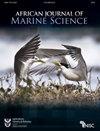南非阿尔戈阿湾未固结海洋生境中底栖生物多样性特征和物理驱动因素
IF 1.4
4区 生物学
Q3 MARINE & FRESHWATER BIOLOGY
引用次数: 0
摘要
松散的海洋沉积物栖息地在空间上占全球海底的大部分,但海底动物群模式及其非生物驱动因素仍知之甚少。南非南海岸阿尔戈亚湾的底栖生物研究主要集中在岩礁上,而对主要的松散沉积物栖息地的研究却很少。本研究描述了Algoa湾30至100米深的松散沉积物的表层底栖生物组合,并调查了生物模式和物理驱动因素之间的关系。根据海底图像对海底生物丰度数据进行了量化,并根据12个非生物因素(包括深度、平均粒度和底部温度)的长期均值和变异系数进行了测试。多变量分析揭示了两个统计上不同的表海底群落。这种模式主要由深度、平均晶粒度、平均底部温度和平均流速(累积变化52.49%)来解释。在较小程度上,底部温度的长期变化,流速和溶解氧也影响了群落(累积变化34.44%)。基质的视觉分类表明,混合基质类型(即沙子和低百分比的岩石)对底栖生物群落有显著影响。研究结果表明,深度和基质类型的结合在很大程度上是观察到的表海底生物组合的原因。本文章由计算机程序翻译,如有差异,请以英文原文为准。
Characterising epibenthic diversity and physical drivers in unconsolidated marine habitats of Algoa Bay, South Africa
Unconsolidated marine sediment habitats spatially make up the majority of global ocean seabed, yet benthic faunal patterns and their abiotic drivers remain poorly understood. Benthic research in Algoa Bay, on the south coast of South Africa, has largely focused on rocky reefs, while the dominant unconsolidated sediment habitats have been poorly studied. This study describes epibenthic assemblages associated with unconsolidated sediment in Algoa Bay, at between 30 and 100 m depth, and investigates the relationship between biotic patterns and physical drivers. Epibenthic abundance data were quantified from benthic imagery and tested against the long-term means and coefficients of variation of 12 abiotic factors, including depth, mean grain size and bottom temperature. Multivariate analyses revealed two statistically distinct epibenthic communities. This pattern was largely explained by depth, mean grain size, mean bottom temperature and mean current speed (cumulative variation of 52.49%). To a lesser extent, the long-term variability of bottom temperature, current speed and dissolved oxygen also influenced the community (cumulative variation of 34.44%). Visual classification of the substrates indicated that a mixed substrate type (i.e. sand and a low percentage of rock) significantly influences the benthic community. The findings suggest that a combination of depth and substrate type are largely responsible for the epibenthic assemblages observed.
求助全文
通过发布文献求助,成功后即可免费获取论文全文。
去求助
来源期刊

African Journal of Marine Science
生物-海洋与淡水生物学
CiteScore
2.60
自引率
16.70%
发文量
17
审稿时长
6-12 weeks
期刊介绍:
The African (formerly South African) Journal of Marine Science provides an international forum for the publication of original scientific contributions or critical reviews, involving oceanic, shelf or estuarine waters, inclusive of oceanography, studies of organisms and their habitats, and aquaculture. Papers on the conservation and management of living resources, relevant social science and governance, or new techniques, are all welcomed, as are those that integrate different disciplines. Priority will be given to rigorous, question-driven research, rather than descriptive research. Contributions from African waters, including the Southern Ocean, are particularly encouraged, although not to the exclusion of those from elsewhere that have relevance to the African context. Submissions may take the form of a paper or a short communication. The journal aims to achieve a balanced representation of subject areas but also publishes proceedings of symposia in dedicated issues, as well as guest-edited suites on thematic topics in regular issues.
 求助内容:
求助内容: 应助结果提醒方式:
应助结果提醒方式:


